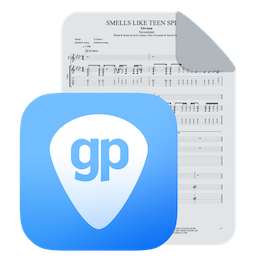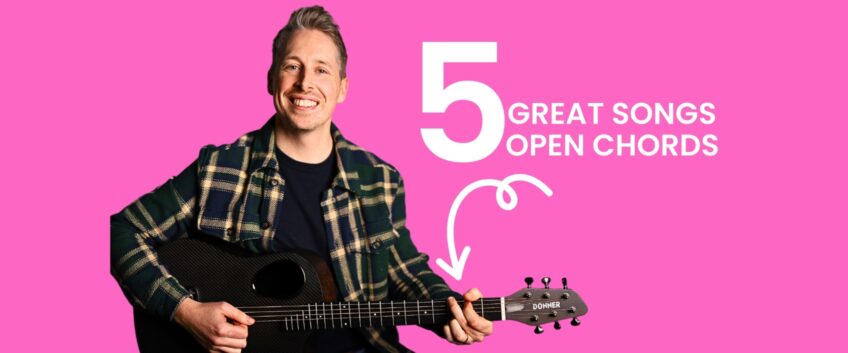
Learn 5 Songs With 5 Open Chords
- 5-songs-with-5-open-chords-gc.gp
- hallelujah-guitar-club.gp
- knockin-on-heavens-door-guitar-club.gp
- save-tonight-guitar-club.gp
- let-it-be-guitar-club.gp
- say-something-guitar-club.gp
Intro
Learning how to play guitar in the early stages can often feel intimidating and overwhelming – there’s just too much information, and our pesky little fingers never seem to move fast enough! But, I can safely assure you that over the course of the first handful of months of learning guitar, you’ll have enough skill and information needed to play along with your favourite tracks!
Open chords are an essential part of most beginners’ journey into the world of guitar, and for good reason – they help unlock the doors to many tracks without having to learn all the more fiddly techniques. On top of that, you only need a handful of open chords to access a large catalogue of music. With that said, I’m going to show you how to play 5 iconic songs that make use of only 5 open chords!
Video
Check out the video below to see a detailed breakdown of how each song is played. This will include what chords are needed, the capo placement, and the strumming patterns for each track. I recommend watching through the video to see which track is your favourite, and start from there!
Remember to download the Guitar Pro tabs for each track down below!
The Chords
There’s a good chance that most of, if not, all of the chords in the video are already familiar to you – which is great! There are, however, a few variations of how to play each chord. So, to make sure that we’re on the same page, the exact chord shapes that we’ll be using will be attached below.
Just in case, the ‘m’ after the chord name means that it is a minor chord. If there is no ‘m’, it means that it is a major chord. The full names of the chords we’ll be using are: C major, G major, D major, A minor and E minor.

If you’re struggling with these chords, or if open chords are completely new to you, be sure to check out our Electric Beginners and Acoustic Beginners courses – they’re full of all the information you’ll need to jump straight into playing along to your favourite songs!
Let’s get to some playing! The video covers all the details of each of the tracks, so please keep referring to it throughout this lesson. The write-up will focus on the strumming patterns and one important chord progression of each track.
Hallelujah
Originally written by Leonard Cohen, this beautiful and timeless track has inspired many to create their own version of it – most famously, Jeff Buckley. The four different chords we’ll need for this one are G, Em, C and D. You’ll need to place our capo on the 5th fret if you want to be able to play along to Jeff Buckley’s version. Something to keep in mind here is that though we’re playing a G major shape, the sound of the chord is a C major – this is the power of the capo! Have a look at the chord progression and strumming pattern attached below:
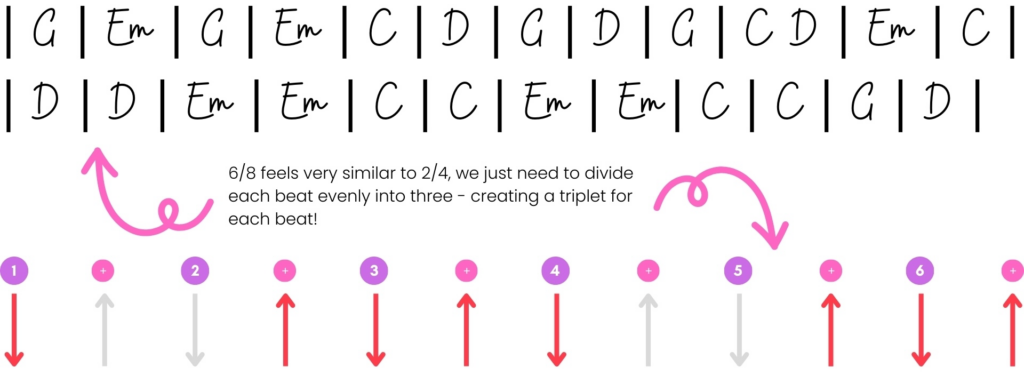
The keen-eyed players might have noticed that the strumming pattern was broken in 6 beats, rather than a more typical 4 beat bar. This is because the track is in the time signature of 6/8, creating a slightly different feel to 2/4. The best way to imagine and count 6/8 is to turn each beat of a bar of 2/4 into a triplet (1 beat broken into 3 evenly spaced notes).
“Struggling to count 6/8 or triplets? Try this! The syllables in the word ‘pineapple’ are perfectly broken into triplets: pi-na-ple. So, you’ll want to replace each beat of a bar of 2/4 into ‘pineapple’!”
Knockin’ on Heaven’s Door
Another track that’s so iconic that it’s been covered by many prolific bands since Bob Dylan first released it in 1991. It just goes to show how much beauty there can be in simplicity! All we need are four chords – G, D, Am and C – to be able to play along to the whole song, as it’s the same progression looped for the entire track! We don’t even need a capo for this one!
We’re going to be playing a strumming pattern broken into 16th notes with plenty of space to achieve the calm and relaxed mood of the song. If you haven’t yet come across 16th note rhythms, give our Beginners Rhythm a try, and you’ll be a master in no time! Both the chord progression and strumming pattern are attached below for you to play along to.
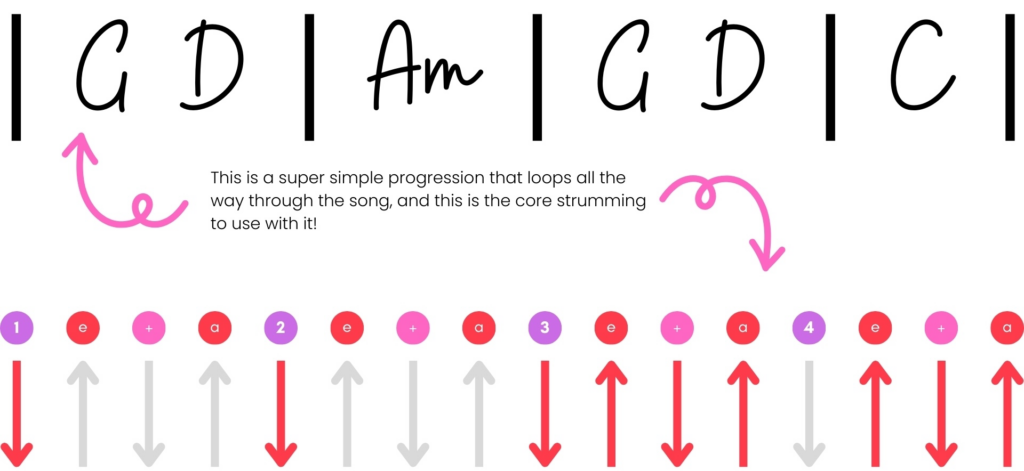
Save Tonight
Eagle-Eye Cherry – maybe not a name known by everyone, but, put Save Tonight on the speakers, and most people won’t be able to help but sing along! This track also makes use of a 16th note strumming pattern, but it’s quite a bit more up-tempo than Knockin’ On Heaven’s Door – so be ready to get your strumming arm warmed up!
Pick that capo back up as well, as we’re going to need to place it on the 5th fret again to make sure we’re playing along in the right key. Follow the diagrams below to play along in no time!
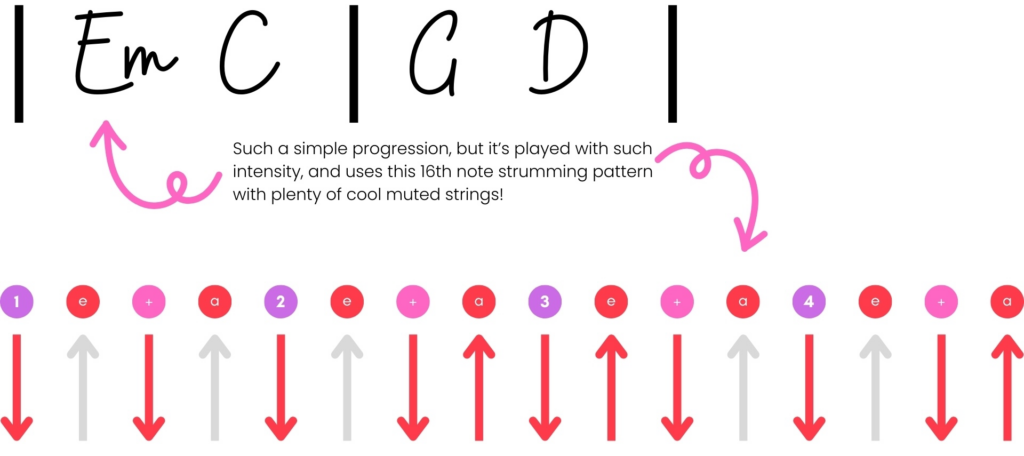
Let it Be
I’m sure you were all waiting to see a track by The Beatles on this list… Let It Be is yet another absolutely timeless track that has inspired countless musicians and non-musicians alike with its words of wisdom and soothing composition. Keep your capo on the 5th fret, and get ready to be lost in the chord progression, as it nicely loops throughout the entire track. A piano plays the chords in the recording, so there is a bit of flexibility in terms of strumming patterns. However, I’ve attached a strumming pattern below which I believe fits the track best.

“Just to avoid any confusion with the loop – the intro uses the first line of the progression once. The loop starts from the beginning once the vocals kick in!”
Say Something
And finally, we’re going to take a look at something a bit more recent – a hit by Justin Timberlake and Chris Stapleton! This upbeat track loops the same four chords throughout with a fun 16th note strumming pattern. You’ll want to put your capo on the 3rd fret if you wanted to play along with the track! Dig in a bit with your strumming to really get the percussive and confident tone! As always, check below for the strumming pattern and chord chart.
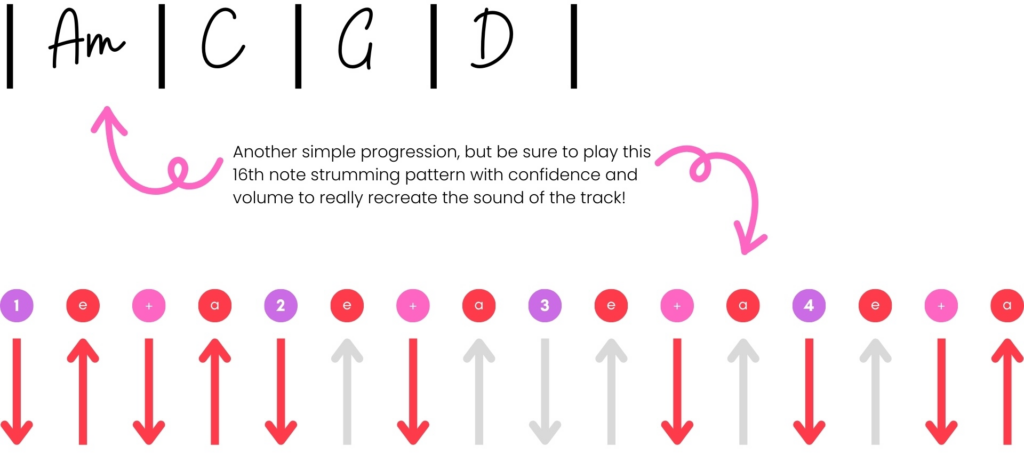
Learn more!
Got these five incredible tracks nailed already and want to learn more? Or maybe you’re ready to tackle some more chords and complex songs! Head on over to the Guitar Club and sign-up for a free trial to take your playing to the next level! And don’t worry if you’re feeling like there’s an information overload – we offer a dedicated pathway to each member to focus on the goals you want to achieve.
P.S. We also have an amazing Youtube channel with hundreds of lessons covering songs, technique and theory. If you liked the tracks on this list, I have a feeling you’ll be a fan of our lesson of the fantastic track, Fast Car – see you there!
Leave a comment
Your email address will not be published.
| Title | Artist | |
|---|---|---|
| I'd Love You to Want Me | Lobo | |
| Dumpweed | Blink-182 | |
| I Drove All Night | Roy Orbison | |
| Aliens Exist | Blink-182 | |
| Highway to Hell | AC/DC |


